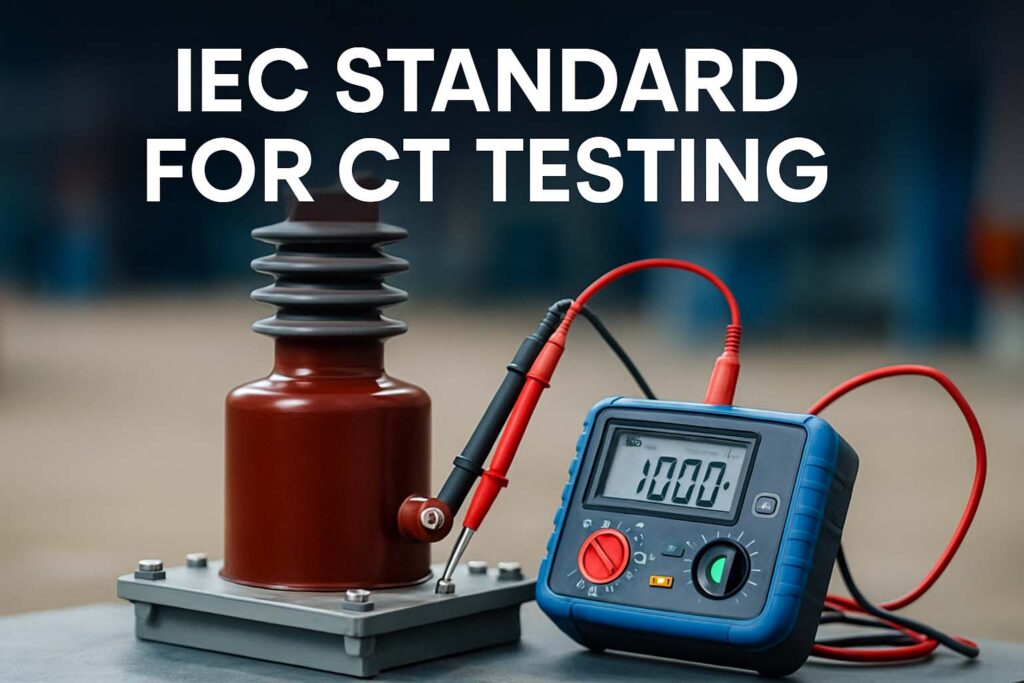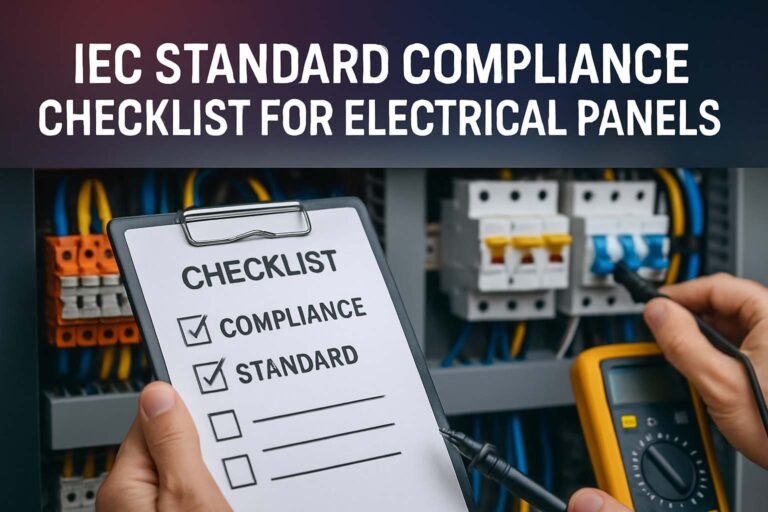IEC Standard for CT Testing: A Complete Technical Guide
Understanding the IEC Standard for CT Testing
Current transformers (CTs) are vital for accurate measurement and protection in electrical power systems. These devices scale down high currents to safe, measurable levels. However, to ensure their reliability and accuracy, CTs must undergo rigorous testing. That’s where the IEC standard for CT testing comes into play.

The International Electrotechnical Commission (IEC) defines the global benchmark for CT performance and testing. The main standards related to CTs are IEC 61869-2 and IEC 60044-1. These guidelines ensure that current transformers meet minimum requirements for accuracy, safety, and insulation under various conditions.
In this article, we will explore the importance of CT testing, the specific procedures defined by IEC, and how these standards apply in real-world scenarios. Whether you’re a testing engineer, an electrical technician, or a quality inspector, understanding the IEC standard for CT testing is essential.
Why CT Testing Matters in Power Systems
Current transformers are commonly used in substations, switchgear panels, and metering setups. If a CT fails, it can cause major errors in current measurement or even lead to the malfunction of protection systems.
Faulty CTs may cause:
- Misoperation of relays
- Inaccurate energy billing
- Potential damage to downstream equipment
- Safety hazards for personnel
Testing ensures that CTs perform reliably throughout their operating life. The IEC standard for CT testing provides the framework for evaluating all these parameters under controlled conditions.
Know more about IEC Standard for Cable Lugs
Key IEC Standards Relevant to CT Testing
The two most recognized standards for CT testing are:
- IEC 61869-2: This standard replaced IEC 60044-1 and applies to instrument current transformers. It defines accuracy classes, performance limits, test procedures, and marking requirements.
- IEC 60044-1: An older standard still in use in many legacy systems. It covers general requirements, electrical characteristics, and routine testing.
Both standards classify CTs based on their intended application, such as metering or protection. The testing criteria vary accordingly.
IEC Standard for CT Testing: Types of Tests Explained
The IEC standard for CT testing includes a combination of type tests, routine tests, and special tests. Each test serves a different purpose in evaluating CT performance.
Type Tests
These are carried out on a prototype CT to verify the design and manufacturing process. They are not performed on every unit. Type tests include:
- Temperature rise test
- Dielectric withstand test
- Short-time current test
- Accuracy test under rated burden and temperature
Know more about IEC Standard for Cable Tray
Routine Tests
Routine tests are performed on every CT before dispatch. These ensure that each unit meets basic performance and safety criteria. Routine tests include:
- Polarity check
- Turns ratio test
- Insulation resistance test
- Secondary winding resistance
- Excitation (saturation) curve
- Accuracy test at rated burden
Special Tests
Special tests are performed on request or under special conditions. These can include:
- Partial discharge test
- Lightning impulse test
- High-frequency response test for IEC 61850-based networks
CT Accuracy Classes According to IEC
The IEC standard for CT testing defines CTs under two primary categories:
- Metering CTs
- Protection CTs
Each category has its own accuracy classes and allowable errors.
Metering CT Accuracy
| IEC Class | Ratio Error (%) | Phase Error (Minutes) |
|---|---|---|
| 0.1 | ±0.1 | ±5 |
| 0.2 | ±0.2 | ±10 |
| 0.5 | ±0.5 | ±30 |
| 1.0 | ±1.0 | ±60 |
These CTs are used in billing and need high accuracy.
Know more about Contact Resistance Test IEC Standard
Protection CT Accuracy
| IEC Class | Composite Error (%) |
|---|---|
| 5P | 5 |
| 10P | 10 |
| PX | Defined by the user |
Protection CTs focus on stability and operation under fault conditions.
CT Excitation Test (Saturation Curve)
One of the most important tests under the IEC standard for CT testing is the excitation test. This test checks how the CT performs as the secondary current increases. The result is an excitation curve that helps determine:
- Knee point voltage (Vk)
- Exciting current (Ie)
- Accuracy limit factor
This test is particularly important for protection CTs as it ensures the core does not saturate under high fault currents.
CT Ratio and Polarity Tests
These two tests are simple but crucial. The ratio test confirms that the CT scales the primary current correctly to the secondary side. Polarity testing ensures that the secondary current direction is consistent with the primary, which is vital for proper relay coordination.
Typical ratio errors for metering CTs should be within ±0.5% or ±1%, depending on the class.
Know more about Circuit Breaker Timing Test Procedure
CT Burden and Load Considerations
The IEC standard for CT testing defines CT performance at a rated burden. Burden is the total impedance (in ohms or VA) seen by the CT’s secondary winding. If the actual burden exceeds the rated burden, accuracy can deteriorate.
| Class | Typical Rated Burden (VA) |
|---|---|
| 0.5 | 10 |
| 1.0 | 15 |
| 5P10 | 15-30 |
Always test the CT under rated burden during accuracy verification.
Safety and Insulation Tests
CTs must withstand high voltages without insulation breakdown. The dielectric tests under IEC include:
- Power frequency withstand test (usually 2kV–4kV for 1 minute)
- Impulse voltage test (for special applications)
- Insulation resistance using a 1000V megohmmeter (values should be >1000 MΩ typically)
These tests ensure safety and durability under operating conditions.
Marking and Documentation
As per IEC standard for CT testing, all CTs must be marked clearly with:
- Rated primary and secondary current
- Accuracy class
- Rated burden
- Serial number and manufacturer
- Rated short-time current
Additionally, the test certificate should include:
- CT ratio test results
- Accuracy test report
- Excitation curve
- Polarity verification
- Insulation resistance test results
Know more about Primary Injection Test vs Secondary Injection Test
Common CT Testing Equipment
For performing tests aligned with IEC standards, the following equipment is commonly used:
- CT analyzer (for ratio, polarity, burden, and excitation tests)
- Digital multimeter and insulation tester
- Primary injection kit (for high-current tests)
- Relay testing kits with CT inputs
Real-World Applications and Compliance
Utilities, manufacturers, and EPC companies use the IEC standard for CT testing to qualify CTs before installation. Compliance with IEC standards ensures CTs will operate effectively in:
- Distribution networks
- Transmission substations
- Industrial switchgear
- Renewable energy plants
Non-compliance can lead to serious system failures, billing inaccuracies, and unsafe operations. That’s why IEC compliance is often a regulatory or project requirement.
Conclusion: Why Follow IEC Standard for CT Testing
In modern power systems, accuracy and reliability are non-negotiable. The IEC standard for CT testing provides the foundation to achieve these goals. From ratio testing to insulation checks, every test aligns CT performance with international expectations.
Following these standards helps:
- Improve system protection accuracy
- Reduce metering losses
- Ensure safe operations under all conditions
- Meet utility and regulatory requirements
Follow Us on Social:
Subscribe our Newsletter on Electrical Insights to get the latest updates in Electrical Engineering.
#IECStandard, #CTTesting, #CurrentTransformer, #ElectricalEngineering, #ProtectionRelays, #IEC60044, #CTAccuracy, #PowerSystems, #TransformerTesting, #CTCalibration, #HighVoltageTesting, #SubstationTesting, #IECStandardsGuide, #InstrumentTransformer, #ElectricalSafety





